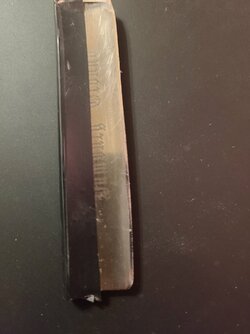This is I think the 3rd time I started from scratch with this clover Morley and sons.
Bevel set at Naniwa 1000
Back at it on the Naniwa 3000
Now it's shaving hair on my leg
Norton 4000, and now it's tree topping
Norton 8000 and now it's smoothly gliding over the hair without cutting ****
What the heck? I'm doing a combination of the rough and fast approach shown by DrMatt357 followed by Lynn's 20+20 circles + 20 X's, until the 8k where I'm only doing Lynn's approach
I've got a few really great edges from other razors, so I keep thinking it's this razor until I saw how sharp it was this time on the 4k, but after the 8k the edge has disappeared.
I used a 325 DMT to lap everything
Bevel set at Naniwa 1000
Back at it on the Naniwa 3000
Now it's shaving hair on my leg
Norton 4000, and now it's tree topping
Norton 8000 and now it's smoothly gliding over the hair without cutting ****
What the heck? I'm doing a combination of the rough and fast approach shown by DrMatt357 followed by Lynn's 20+20 circles + 20 X's, until the 8k where I'm only doing Lynn's approach
I've got a few really great edges from other razors, so I keep thinking it's this razor until I saw how sharp it was this time on the 4k, but after the 8k the edge has disappeared.
I used a 325 DMT to lap everything



